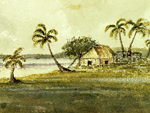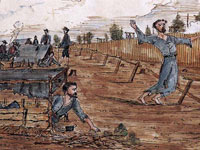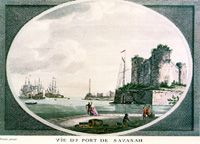Brian Carlin: Picturing America is a project by the National Endowment for the Humanities. What it was it's a resource kit, but it's beyond the regular curriculum kit. It's not a little box, it's huge. 20x30 size posters of 40 iconic images in American History from the Revolution to the present day era. It was an open call for schools and districts to apply and every school could apply for it. And our—in New York City, every school got one—every public school in New York City got one. So we developed, along with the city, lessons using the images and looking at art in general and tailored it to classroom use—elementary, middle, and high school.
Philip Panaritis: We've been able to use those images both in our training and TAH sessions. Also we sponsored after-school workshops for teachers. How are we using it? First it was a question of go find it, because teachers would say, "Oh, we didn't get that!" but of course they did. Sometimes it was in a storage closet or it was decorating the principal's office. So the first step in using Picturing America has been to go get it. The images are front and back so lots of times they have been displayed in a hallway or permanently, which of course means a teacher can't use them in their classroom, and you also lose the one that's on the reverse.
The first thing that we've had to do is ascertain, "Yes, you have this somewhere, let's see if we can put it in the hands of teachers." Sometimes there's a lot of proprietary notions in a school that come in and someone—it could be the guy on the loading dock, it could be the principal—but someone says, "That goes to the librarian" or "That goes to the art teacher." And, depending on how professionally generous that person is, she or he may share it with other teachers or not, in which case some—and those are the worse cases—but in general we've found that it's a great resource, it's free. The teaching spiral binder that comes with it provides more than adequate [background material]; you don't have to be an art historian to see some of the context of it. And it's been a lot of fun.
Philip Panaritis: We consist of 10 full-day sessions plus two walking tours. One is downtown New York; last year we did the other one uptown in Harlem. There's a series of after-school workshops and book signings by artists and historians that are—those are open to that cohort and all the teachers that are in and have gone through the various grants, which is now hundreds of people in that community.
For the workshop that we just did we put together a slideshow. One of the images in Picturing America is Washington Crossing the Delaware, Emanuel Leutze's giant painting. We gave them all copies on a CD today of the slideshow where we had found 50 different iterations of that image that were used to sell puzzles, sell knives, sell Budweiser beer in 1776[?], sell Las Vegas tourism, all sorts of [uses] from the sacred to the profane. So that was kind of just fun for the teachers and fun for the kids to see. But there's a serious message there, as well, about how images are used to sell things and who owns history and who owns the images and how they can be twisted really in a variety of different ways or manipulated.
Philip Panaritis: The other thing is that the venue for over half the sessions is in New York Historical—or in tje Museum of the City of New York or Brooklyn Museum of Art. With the museum educator we do gallery walks so they actually have—and its nice to live in a big city like that because the point of doing that is for them to see the image in its own [setting]. And usually some of them are huge, they have no idea how big they are, they see details that they couldn't see, even in the Picturing America blow-ups. But secondly that they bring the youngsters back for field trips.
The museum educators and Brian and I try very hard to adopt and to model a rigorous method of looking at images, whether it's a photograph, or sometimes we use the quadrant where you have a piece of paper and you're only going to move it and look at this. And that's good for kids, and good for teachers too, because their eyes are naturally drawn to the central figure usually and we tend to jump to conclusions without looking carefully. So what do you see? Then what does it mean? Then what is the evidence for that, defend your conclusion. One of the things that is nice about art, unlike other aspects of teaching history, it seems to lend itself to talking about feelings. And what do you see in that migrant mother in Dorothea Lange's picture? And what is the evidence that you see shame or pride or desperation, specifically talk about how the photograph shows that or the painting.
So that's a lot of fun, what does it mean, and then one of the questions, and we work with good historians and good art historians who know that one of the things that even in their field is what don't we know? And so it isn't like, here's all the answers I'm going to pour into your head, but if it's really a good historian or a good art history person then they talk about things that are unknown, that there's two or three or four different schools of thought about, that it's possible he posed it that way because. . . ? And what do you think?
Brian Carlin: We don't just take the teachers to the museum and say, "Oh, it's great we're increasing their content knowledge." We're increasing their content knowledge, we're building their pedogogy, but now we're bringing them to a place they can bring their students to. That's their local institutions, they're really good institutions, and they've got the training to do it and now they go there and it brings it all together nicely. From the professors and Phil and I, to the museum educators, to the teachers, and all the way down to the students.


